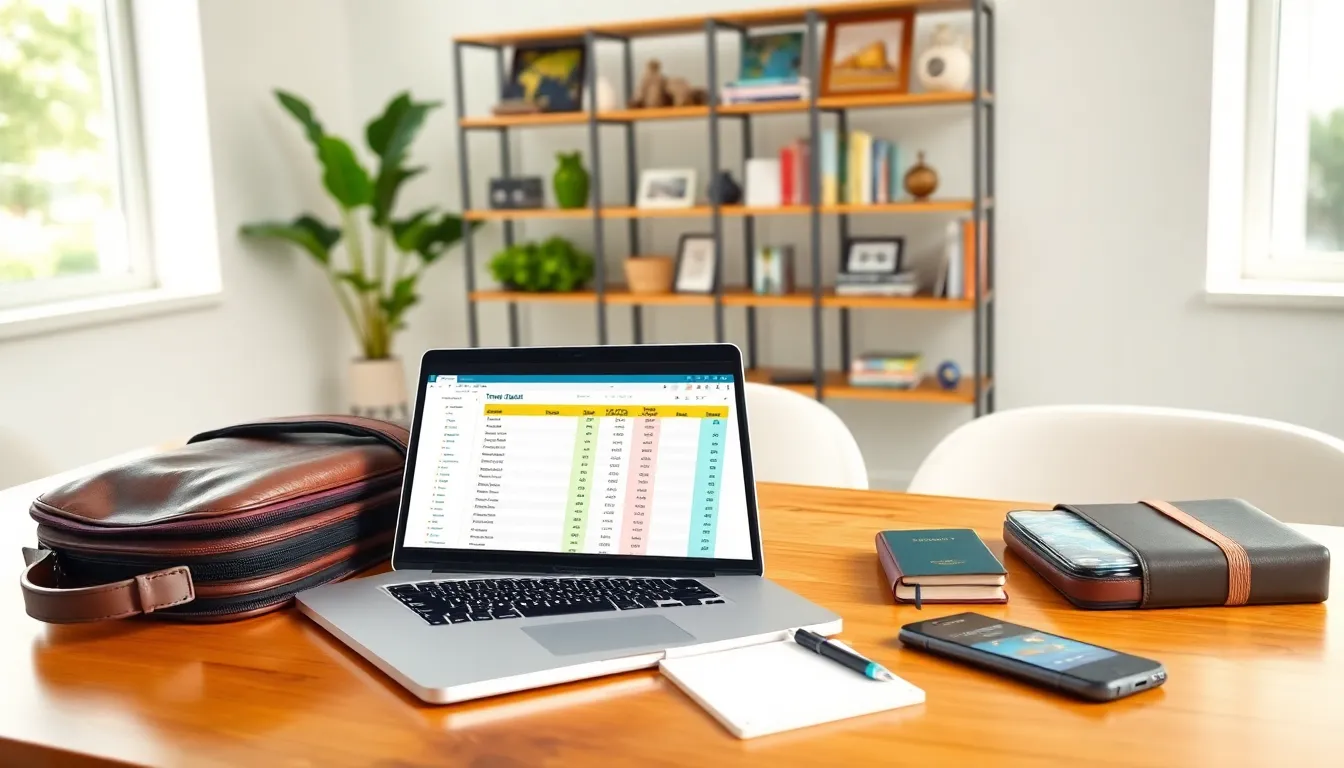Traveling is exhilarating, but it can also bring unexpected expenses that make even the best trips feel like a budget nightmare. Imagine this: enjoying a beautiful sunset on a tropical beach, only to realize you’ve overspent your travel funds and now have to eat instant noodles for dinner. Not the vibe, right? That’s where a travel budget spreadsheet swoops in like a superhero, helping travelers like him or her keep their finances in check while still enjoying every moment of their trip. So, how does one create this financial lifeline? Let’s immerse and discover the realm of budgeting for travel, ensuring every dollar counts and laughter remains part of the itinerary.
Table of Contents
ToggleImportance Of A Travel Budget Spreadsheet

A travel budget spreadsheet is more than just a neatly organized table: it’s the backbone of any successful journey. This tool aids in visualizing expenses, making travel planning smoother than a fresh cup of coffee on a Monday morning. For many travelers, the actual costs can far exceed preliminary estimates, leading to frustration and disappointment. By budgeting effectively, travelers can avoid detrimental financial surprises and instead revel in the joys of exploration.
Also, using a travel budget spreadsheet can make it easier to prioritize experiences. Whether it’s choosing between a five-star restaurant or an adventure park, having a clear view of finances empowers travelers to make informed decisions. They can spend wisely and still enjoy unforgettable moments without the constant worry of overspending. In other words, a travel budget spreadsheet turns financial chaos into clarity.
Components Of A Travel Budget Spreadsheet
Understanding the essential components of a travel budget spreadsheet is crucial for successful planning. Here are the key elements:
- Fixed Costs: These are the expenses that tend to remain stable, such as flights and accommodation. These should be entered first to set a solid financial foundation.
- Variable Costs: Unlike fixed costs, these can fluctuate. Think meals, tours, and shopping. Including a buffer for unexpected costs can save a day from turning into a financial fiasco.
- Daily Spending Limit: Identifying a daily spending limit can help travelers stay disciplined while exploring. A bit of forecasting goes a long way.
- Total Estimated Costs: This is a summary of all projected expenses. Seeing everything laid out provides a clearer picture of how much money is really needed.
A well-structured spreadsheet includes these components, leading to smoother travels and a mindset focused on enjoyment rather than financial panic.
How To Create A Travel Budget Spreadsheet
Creating a travel budget spreadsheet doesn’t require a degree in rocket science. Here’s a step-by-step guide to crafting a budget that even a novice can handle:
- Choose Your Tool: Start with software that suits your style, be it Microsoft Excel, Google Sheets, or a specialized budgeting app. Each option has its strengths, so pick one that aligns with your tech skills.
- Set Up the Framework: Begin by labeling columns like categories (flights, accommodation), anticipated costs, actual costs, and notes. A simple setup can be more effective than a complex one.
- Input Fixed Costs: Fill in the numbers for the fixed costs you can’t escape. This often includes flights and accommodation, but also consider any pre-booked tours or activities.
- Estimate Variable Costs: Allocate funds for food, entertainment, and spontaneous adventures. It’s better to overestimate slightly to avoid unwanted surprises.
- Track Expenses in Real-Time: During the trip, update the spreadsheet regularly. This keeps the budget fresh and relevant, preventing anyone from losing track of their spending.
- Review and Adjust: After the trip, analyze the data. What went well? What was surprisingly expensive? This reflection helps future planning efforts become even more efficient.
With this approach, managing a budget turns from a tedious task into an enjoyable challenge.
Tips For Managing Your Travel Budget
Anyone can create a travel budget spreadsheet, but managing it effectively is another story. Here are some actionable tips to maintain control over those precious dollars:
- Be Realistic: When estimating costs, make sure they reflect actual prices. While that extravagant beachfront villa may be tempting, do consider more budget-friendly alternatives.
- Prioritize: Decide what’s essential and what can be compromised. If dining out is a priority but souvenir shopping isn’t, adjust the budget accordingly.
- Use Cash When Possible: Using cash for daily expenses can ensure a person sticks to their budget more effectively. It’s easier to see when funds are running low.
- Stay Flexible: Sometimes plans change. A spontaneous day trip might come along that’s too good to pass up. Be willing to adjust the budget on the fly.
- Use Technology: Budgeting apps can help track expenses in real-time, offering updates when necessary. These apps can alert travelers about overspending and help manage costs dynamically.
These strategies can mean the difference between �walking in a blissful daze or tripping over financial missteps.
Common Mistakes To Avoid When Budgeting
Budgeting can feel overwhelming, especially on the heels of a million travel desires. To dodge costly pitfalls, here are some common mistakes to steer clear of:
- Ignoring Sharing Costs: Traveling with a group? Don’t forget to consider shared expenses like accommodations and rental cars. Splitting costs can significantly reduce financial strain.
- Underestimating Costs: Travelers often overlook daily expenses, such as snacks or unplanned excursions. Small expenses can accumulate quickly, so it’s crucial to be thorough.
- Neglecting Currency Fluctuations: For international travel, local currency fluctuations can impact budgeting significantly. Stay informed about the current exchange rates.
- Leaving Home Without Backup Funds: Having a safety net can save someone from a travel blunder. Link a credit card and a small reserve of cash as backup options.
Awareness of these mistakes can equip travelers with tools for preventing budget pitfalls.
Tools And Resources For Your Travel Budget Spreadsheet
Travel budgeting has evolved with technology, providing various tools and resources to simplify the planning process. Here’s a quick look at the best options available:
- Google Sheets: A free, collaborative tool that allows sharing and real-time updates. It’s perfect for travelers who want to share their spreadsheets with friends and family.
- Excel Templates: Many users prefer Excel for its advanced features, especially with pre-designed budgeting templates available online.
- Budgeting Apps: Apps like Mint and YNAB (You Need a Budget) provide excellent mobile banking integration, making it easy for travelers to monitor expenses on the go.
- Expense Trackers: Tools like Expensify can help travelers keep tabs on receipts, ensuring no expense slips through the cracks.
Using these resources can streamline financial planning and keep stress off the itinerary.





